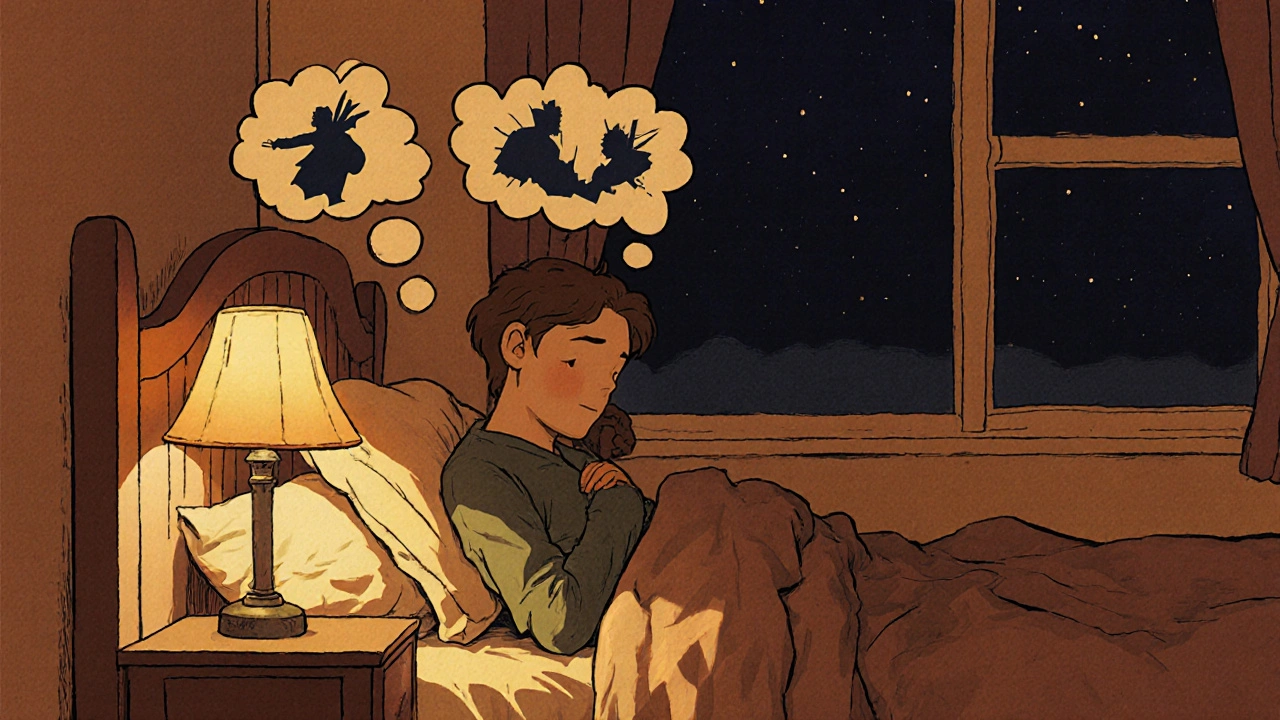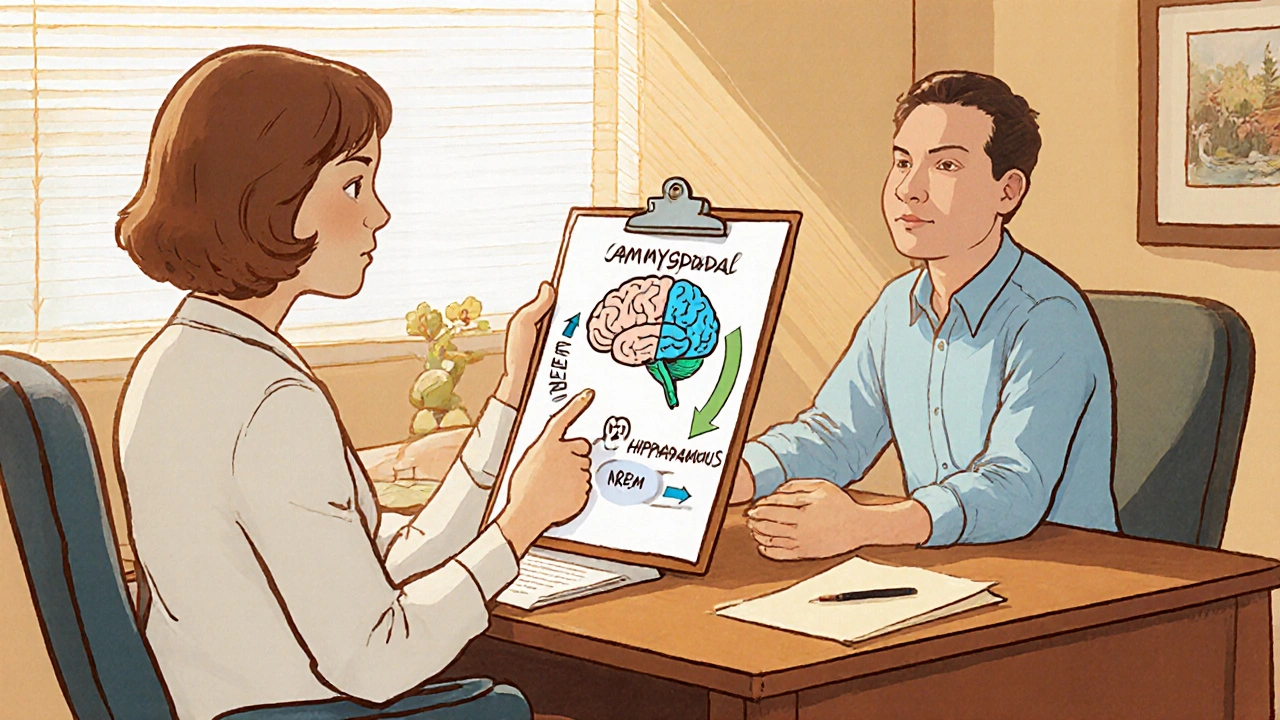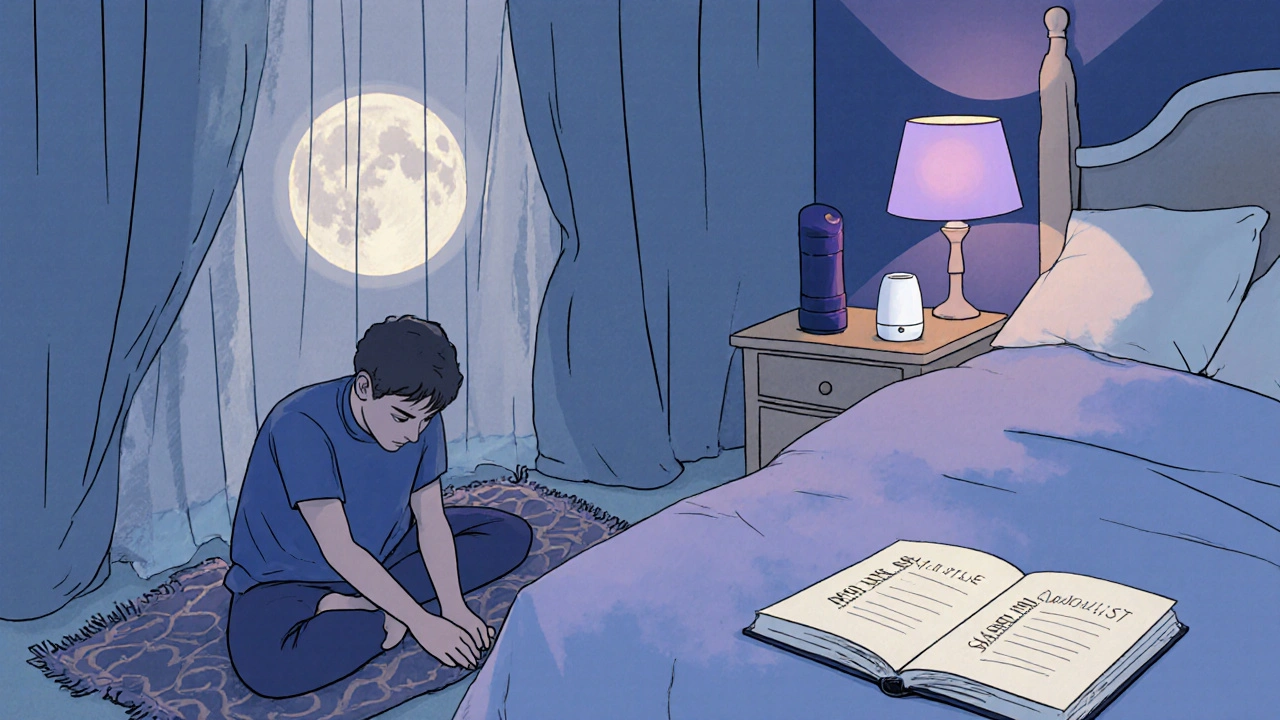Sleep’s Impact on PTSD Recovery - Key Insights

When you’re trying to bounce back from a traumatic event, getting a solid night’s rest might feel like a luxury. In reality, PTSD recovery hinges on how well you sleep. Below we break down the science, common sleep hurdles, and practical steps you can take right now.
Key Takeaways
- Sleep loss amplifies fear circuitry, making flashbacks and hyperarousal worse.
- REM sleep is crucial for emotional processing; disrupted REM ties directly to nightmare frequency.
- Simple sleep‑hygiene tweaks combined with evidence‑based therapy can cut PTSD symptoms by up to 30%.
- Professional assessment (polysomnography, CBT‑I) is worth it if insomnia persists beyond a month.
- Consistent, restorative sleep speeds up overall trauma recovery.
What Sleep Does for the Brain
Posttraumatic Stress Disorder is a mental health condition triggered by experiencing or witnessing a traumatic event, characterized by intrusive memories, hyperarousal, and avoidance isn’t just a matter of mood-it rewires the brain. During sleep, two stages dominate the restorative process:
REM sleep (rapid eye movement phase where dreaming peaks and emotional memory consolidation occurs) helps the brain file away upsetting experiences, turning raw fear into a manageable narrative. When REM is cut short, the amygdala (the brain’s alarm center that flags threats and triggers fight‑or‑flight responses) stays on high alert, feeding the hypervigilance seen in PTSD.
Conversely, NREM sleep (non‑rapid eye movement stages that support physical repair and memory replay for factual information) allows the hippocampus (the memory hub that transfers short‑term memories into long‑term storage) to sort facts separate from feelings. A balanced mix of NREM and REM gives the brain a chance to separate the event’s details from the raw terror.
Why People with PTSD Struggle to Sleep
Trauma leaves a physiological imprint. The body’s stress hormone, cortisol (a glucocorticoid released by the adrenal glands in response to stress, influencing metabolism and immune function), often stays elevated at night, disrupting the natural sleep‑wake cycle. This hormonal surge triggers:
- Difficulty falling asleep (sleep onset insomnia)
- Frequent awakenings (maintenance insomnia)
- Intense, vivid nightmares that snap you out of REM
Many patients also report a heightened parasympathetic nervous system (the branch of the autonomic nervous system that promotes rest, digestion, and recovery) activity deficit, meaning the body never fully “switches off.” The result is a feedback loop: poor sleep fuels anxiety, which then deepens the sleep problem.

Research Snapshot: Sleep Interventions and PTSD Symptoms
Over the past decade, dozens of clinical trials have measured how improving sleep changes PTSD outcomes. A 2023 meta‑analysis of 27 randomized studies found that participants who received any form of sleep‑focused therapy (CBT‑I, imagery rehearsal, or pharmacologic melatonin) experienced a 28% greater reduction in PTSD severity scores compared to control groups.
Key findings include:
- CBT‑I (Cognitive Behavioral Therapy for Insomnia) consistently lowered insomnia severity and, as a side effect, cut intrusive memories by an average of 2.6 points on the Clinician‑Administered PTSD Scale.
- Imagery Rehearsal Therapy (IRT), which rewrites nightmare scripts, reduced nightmare frequency by 45% and improved overall sleep efficiency.
- Low‑dose melatonin (a hormone that regulates the sleep‑wake cycle, often taken as a supplement to promote sleep onset) helped re‑establish circadian rhythm without exacerbating daytime sedation.
These numbers matter because they show that targeting sleep isn’t an add‑on; it’s a core component of trauma healing.
Practical Steps to Improve Sleep Right Now
Below is a “sleep‑first” checklist you can start tonight. Each tip is backed by research and easy to fit into a busy schedule.
- Set a consistent bedtime. Go to bed and wake up within a 30‑minute window every day. Consistency stabilizes cortisol rhythms.
- Limit screen exposure. Blue light suppresses melatonin. Use night‑mode settings or a blue‑light filter after 8 p.m.
- Create a “wind‑down” ritual. Gentle stretching, deep‑breathing, or a short mindfulness session signals the brain that it’s time to switch off.
- Adjust the bedroom environment. Keep the room cool (around 65 °F), dark, and quiet. Consider white‑noise machines if you’re sensitive to sudden sounds.
- Watch caffeine and alcohol. Both interfere with REM; aim for caffeine no later than 2 p.m. and keep alcohol under 1 drink per night.
- Try a short “body scan” meditation. Focus on relaxing each muscle group from toes to head; this reduces hyperarousal linked to the amygdala.
- Consider a melatonin supplement. 0.5 mg taken 30 minutes before bedtime can help reset the circadian clock without heavy side effects.
If insomnia persists beyond two weeks, move to the next tier of help.
When to Seek Professional Help
Self‑help works for many, but certain red flags call for a clinician:
- Insomnia lasts longer than a month and worsens despite the checklist.
- Nightmares occur nightly and leave you exhausted during the day.
- You notice severe daytime anxiety, depression, or thoughts of self‑harm linked to poor sleep.
At that point, a sleep specialist can run a polysomnography (a comprehensive sleep study that records brain waves, oxygen levels, heart rate, and breathing during sleep) to pinpoint physiological disruptions. The results guide whether you need:
- CBT‑I - a structured 6‑8 week program that reshapes thoughts about sleep and introduces stimulus control techniques.
- Imagery Rehearsal Therapy - works with a therapist to rewrite the script of recurring nightmares.
- Medication such as low‑dose prazosin (targets nightmares) or selective serotonin reuptake inhibitors (address overall PTSD symptoms).

Comparing Sleep Stages and Their PTSD Impact
| Stage | Typical Duration (per cycle) | Key Brain Activity | Relevance to PTSD |
|---|---|---|---|
| REM | 10-25 min | High amygdala activity, vivid dreaming | Facilitates emotional processing; disruption heightens nightmares and flashbacks. |
| NREM (Stage 3‑4) | 20-40 min | Slow‑wave activity, hippocampal replay | Supports factual memory consolidation; loss weakens context separation, making triggers more intrusive. |
| Light Sleep (Stage 1‑2) | 5-20 min | Transition between wakefulness and deep sleep | Fragmented light sleep leads to frequent awakenings and heightened vigilance. |
Next Steps for Sustained Healing
Recovery is a marathon, not a sprint. Pairing sleep‑focused tactics with broader trauma work (exposure therapy, mindfulness, support groups) yields the best outcomes. Here’s a simple weekly plan you can adapt:
- Monday‑Friday: Follow the sleep‑hygiene checklist, log bedtime and quality in a journal.
- Saturday: Review your sleep log with a therapist or trusted friend; note patterns.
- Sunday: Schedule a brief 20‑minute “body scan” meditation before bed to reset the nervous system.
- Weekly therapy: Attend CBT‑I or IRT sessions if you’ve been referred.
Stick with the routine for at least six weeks-most neural changes need time to cement.
Frequently Asked Questions
Can I recover from PTSD without improving my sleep?
Sleep is a cornerstone of emotional regulation. While therapy can mitigate symptoms, untreated insomnia often stalls progress, leading to relapse or chronic distress.
Is melatonin safe for long‑term use?
Low‑dose melatonin (0.5‑3 mg) is generally safe for up to a year. It’s best to taper off under a doctor’s guidance to avoid dependence on supplements.
Why do nightmares feel more vivid after a trauma?
During REM, the amygdala remains hyperactive, replaying emotional memories as dreams. Trauma intensifies this response, so nightmares become louder and more detailed.
Do I need a sleep study for PTSD‑related insomnia?
If insomnia lasts beyond a month, causes daytime impairment, or is accompanied by frequent nightmares, a polysomnography can uncover hidden sleep‑apnea or periodic limb movements that exacerbate PTSD symptoms.
Can I combine CBT‑I with medication?
Yes. Many clinicians pair CBT‑I with low‑dose prazosin or SSRIs. The therapy tackles behavioral patterns while medication controls physiological arousal.
Sleep might feel like a small piece of a massive puzzle, but it’s often the piece that holds everything together. By making sleep a priority, you give your brain the chance to process trauma, lower anxiety, and set the stage for lasting healing.
Sebastian Green
October 20, 2025 AT 18:24Wow, this breakdown really hits home. I’ve been struggling with night terrors after my deployment, and reading about REM’s role gives me a bit of hope. It’s comforting to know that something as simple as a consistent bedtime can shift the brain’s wiring. I’m going to start logging my sleep and try that short body‑scan meditation before bed. Thanks for laying it all out in a clear, compassionate way.
Wesley Humble
October 25, 2025 AT 18:24While the article is commendable for its breadth, it suffers from an over‑reliance on anecdotal recommendations rather than rigorous meta‑analytic quantification. The cited 28% symptom reduction, though impressive, demands a confidence interval and heterogeneity assessment before being heralded as definitive. Moreover, the insinuation that melatonin universally benefits PTSD patients neglects its pharmacokinetic variability across genotypes. Nonetheless, the structural hierarchy of sleep stages is accurately portrayed. 🙂 😐
Alex Pegg
October 30, 2025 AT 18:24Honestly, the whole “sleep first” mantra feels like a corporate wellness buzzword. Most vets won’t have the luxury of a consistent bedtime anyway.
laura wood
November 4, 2025 AT 18:24I hear your concerns, Alex, but the data suggest that even modest adjustments can yield measurable neural benefits. Remember, cultural stigma around sleep often amplifies the very isolation we’re trying to combat. Small routines can become anchors in a chaotic recovery journey.
Natalie Morgan
November 9, 2025 AT 18:24Sleep is a gatekeeper for memory processing. Simple changes can reset that gate. Try tracking bedtime and wake time. Consistency matters.
Israel Emory
November 14, 2025 AT 18:24Indeed, the act of tracking, while seemingly trivial, provides a feedback loop, a mechanism, a mirror, reflecting circadian regularity; it empowers the individual, and, importantly, it offers clinicians quantifiable data, which, in turn, facilitates tailored interventions, thereby enhancing therapeutic outcomes.
barnabas jacob
November 19, 2025 AT 18:24From a psychoneuroimmunology perspective, the dysregulation of cortisol cascades into maladaptive neuroplasticity, which, frankly, many “self‑help” articles overlook. The therapeutic regimen must incorporate therapeautic modalities that target both somatic and cognitivve layers. Otherwise, we’re just patching a leak while the hull is rotting.
jessie cole
November 24, 2025 AT 18:24To build upon Barnabas’s points, integrating CBT‑I with a structured sleep hygiene protocol can bridge that gap between theory and practice. Let us remain steadfast in our commitment to evidence‑based interventions, for the stakes are undeniably high.
Kirsten Youtsey
November 29, 2025 AT 18:24One must question whether the mainstream narrative surrounding sleep is not, in fact, a meticulously engineered construct designed to distract the populace from deeper sociopolitical machinations. The obsessive focus on melatonin, for instance, conveniently diverts attention from the more insidious nocturnal surveillance infrastructures now embedded in our very bedding. Such considerations compel a reevaluation of the purported “scientific consensus.”
Matthew Hall
December 4, 2025 AT 18:24The government doesn’t want you sleeping well, they want you dreaming about their agenda.